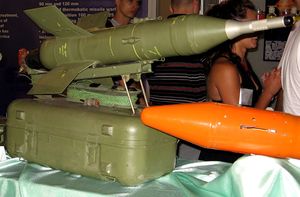9K11 Malyutka
| 9K11 Malyutka | |
|---|---|
 The 9M14M missile |
|
| Type | Anti-tank missile |
| Place of origin | |
| Service history | |
| In service | 1961-present |
| Used by | Soviet Union and others |
| Wars | Yom Kippur War Vietnam War Western Sahara War Iraq Iran War Gulf War Croatian war of independence 2006 Lebanon War |
| Production history | |
| Designer | Design Bureau of Machine-Building (KBM, Kolomna) |
| Designed | 1960s |
| Produced | 1961 |
| Variants | 9M14M, 9M14P1, Malyutka-2, Malyutka-2F |
| Specifications | |
| Weight | 10.9 kg (9M14M) 11.4 kg (9M14P1) 12.5 kg (Malyutka-2) ~12 kg (Malyutka-2F) |
| Length | 860 mm 1005 mm combat ready (Malyutka-2) |
| Width | 393 mm (wingspan) |
| Diameter | 125 mm |
|
|
|
| Effective range | 500-3000 m |
| Warhead weight | 2.6 kg (9M14M, 9M14P1) 3.5 kg (Malyutka-2, Malyutka-2F) |
|
|
|
| Speed | 115 m/s (9M14M, 9M14P1) 130 m/s (Malyutka-2, Malyutka-2F) [1] |
| Guidance system |
MCLOS |
The 9K11 Malyutka (Russian: Малютка; little one, NATO reporting name: AT-3 Sagger) is an MCLOS wire-guided anti-tank guided missile developed in the Soviet Union. It was the first man-portable anti-tank guided missile of the Soviet Union and is probably the most widely produced ATGM of all time—with Soviet production peaking at 25,000 missiles a year during the 1960s and 1970s. In addition copies of the missile have been manufactured under various names by at least five countries.
Contents |
Development
Development began in July 1961 with the government assigning the project to two design teams: Tula and Kolomna. The requirements were:
- vehicle mountable and/or man portable
- range of 3000 meters
- armor penetration of 200 millimetres at 60°
- weight at most 10 kilograms.
The designs were based on the western ATGMs of the 1950s, such as the French Entac and the Swiss Cobra. In the end, the prototype developed by the Kolomna Machine Design Bureau, who were also responsible for the AT-1 Snapper, was chosen. Initial tests were completed by 20 December 1962, and the missile was accepted for service on 16 September 1963.
Description
The missile can be fired from a portable suitcase launcher (9P111), ground vehicles (BMP-1, BRDM-2) and helicopters (Mi-2, Mi-8, Mi-24, Soko Gazelle). The missile takes about 5 minutes to deploy from its 9P111 fibreglass suitcase, which also serves as the launching platform.
The missile is guided to the target by means of a small joystick (9S415), which requires profound training of the operator. The operator's adjustments are transmitted to the missile via a thin three-strand wire that trails behind the missile. The missile climbs into the air immediately after launch, which prevents the missile hitting obstacles or the ground. In flight the missile spins at 8.5 revolutions per second—it is initially spun by its booster, and the spin is maintained by the slight angle of the wings. The missile uses a small gyroscope to orient itself relative to the ground; as a result the missile can take some time to bring back in line with the target, which gives it a minimum range of somewhere between 500 m and 800 m. For targets under 1000 m, the operator can guide the missile by eye; for targets beyond this range the operator uses the 8x power, 22.5 degree field of view 9Sh16 periscope sight.
The engagement envelope is a 3 km, 45 degree arc centered on the missiles launch axis. At ranges under 1.5 km this arc reduces, until at 500 m range the missile can only hit targets 50 m either side of the center line. It should be noted that accuracy falls off away from the launch axis—falling to approximately half its optimal accuracy at the extremes.
While early estimates of the missile hitting the target ranged from 90% to 60%, experience has shown that it is really between 25% and 2% depending on the situation and skill of the operator. MCLOS requires considerable skill on the part of the operator: reportedly it takes 2,300 simulated firings to become proficient with the missile as well as 50 to 60 simulated firings a week to maintain the skill level.
The two most serious defects of this weapon system are its minimum range of between 500 m and 800 m (targets that are closer cannot be effectively engaged) and the amount of time it takes the slow moving missile to reach maximum range—around 30 seconds—giving the intended target time to take appropriate action, either by retreating behind an obstacle/dune, laying down a smoke-screen, or by returning fire on the operator.
Later versions of the missile addressed these problems by implementing the much easier to use SACLOS guidance system, as well as upgrading the propulsion system to increase the average flight speed.

History
In Soviet service the man-portable version was deployed as part of the anti-tank platoon of motor rifle battalions. Each platoon has two Malyutka sections, each with two teams. Each team has two launcher stations. One assistant gunner in each team serves as a RPG-7 gunner. The RPG-7 is needed to cover the 500 meter deadzone created by the minimum range of the missile. It is also an integrated part of the BMP-1, BMD-1, and BRDM-2 vehicles.
Vietnam War
On 23 April 1972, the recently organized ARVN (Army Republic of South Vietnam) 20th Tank Regiment was attacked by the NVA (North Vietnamese Army) employing the 9M14M Malyutka anti-tank guided missile for the first time.[2] The 20th was the only South Vietnamese armor unit equipped with the M48 Patton tank. This first employment of the Malyutka destroyed one M48A3 and one M113 Armored Cavalry Assault Vehicle (ACAV), and a second ACAV was damaged.[3]
During this engagement with the weapon, the ARVN tankers appeared fascinated by the missile's slow and erratic flight,[4] but through experience, they soon deployed counter measures against the weapon system. Upon launching by the enemy, ARVN crewmen would fire all weapons towards the Sagger's firing position, which would make the gunner flinch and lose control of his missile. Although the gunner could take cover away from the launch site, the joystick control wire only allowed fifteen meters of clearance. During the engagement the ARVN eventually lost eight tanks to the 9M14M missile, but had developed procedures to defend themselves against it.[2]
Yom Kippur War
The missile was used successfully in the 1973 Yom Kippur War by the Syrian and Egyptian armies. On average each missile team expended 20 rounds—or about 2,000 rounds per division during the war. Soviet sources claim that the missile accounted for 800 Israeli tank losses, though some sources report as high as 1,063 — this probably includes tanks that were out of action for less than 24 hours and then returned to duty after repairs.[5]
Sino - Vietnam border conflict
In the 1979 Sino-Vietnamese border conflict at least one PLA tank was destroyed by a Vietnamese anti-tank missile. It is most likely that the Malyutka system was used. The explosion of the missile's warhead triggered a secondary explosion of onboard ammunition, which totally destroyed the tank with the loss of all crew.
In the 1980s, there was at least one incident of Vienamese forces firing Malyutkas at Chinese positions. At one point a PLA soldier was killed after pushing his platoon commander away. Records from this case indicate that one could certainly hear the approaching Malyutka and take evasive actions.
Models
- AT-3 Sagger
- AT-3A Sagger A 9M14 Malyutka wire-guided MCLOS Entered service in 1963.
- AT-3B Sagger B 9M14M Malyutka-M wire-guided MCLOS Entered service in 1973 improved motor, reducing flight time to maximum range. Mass 11 kg. Range 3 km.
- AT-3C Sagger C 9M14P Malyutka-P wire-guided SACLOS
- 9M14P Improved warhead 460 mm versus RHA, Entered service in 1969
- 9M14P1 Improved warhead 520 mm versus RHA with a stand off probe for improved capability against ERA.
- 9M14MP1
- 9M14MP2
- AT-3D Sagger D wire-guided SACLOS entered service in the 1990s. Mass 13 kg. Range 3 km. Speed improved to 130 m/s.
- 9M14-2 Malyutka-2 3.5 kg HEAT warhead 800 mm penetration versus RHA. Entered service in 1992. Weight 12.5 kg.
- 9M14-2M Malyutka-2M 4.2 kg tandem HEAT warhead for improved capability against ERA. Weight 13.5 kg. Speed 120 m/s.
- 9M14-2P Malyutka-2P
- 9M14-2F Malyutka-2F 3.0 kg thermobaric warhead. Intended for use against troops and soft vehicles.
- 9M14P-2F
- 9M14-2T Serbian Yugoimport SDPR Malyutka-2T SACLOS 4.4 kg tandem HEAT warhead 1,000 mm penetration versus RHA, improved capability against ERA. Weight 13.7 kg. Speed 120 m/s
- HJ-73 Hongjian Red Arrow-73 China
- HJ-73 MCLOS entered service in 1979
- HJ-73B SACLOS
- HJ-73C SACLOS stand off probe for improved capability against ERA
- RAAD Iran
- RAAD
- I-RAAD stand off probe for improved capability against ERA
- Susong-Po North Korean
- POLK Slovenia based on the AT-3C
- Kun Wu 1 Taiwan
List of past and present operators
 Afghanistan
Afghanistan Albania
Albania Algeria
Algeria Angola
Angola Armenia
Armenia Bangladesh
Bangladesh Bosnia and Herzegovina
Bosnia and Herzegovina Bulgaria
Bulgaria People's Republic of China
People's Republic of China Croatia
Croatia Cuba
Cuba Turkey - Out of service
Turkey - Out of service Czechoslovakia
Czechoslovakia Egypt
Egypt Ethiopia
Ethiopia Hezbollah
Hezbollah Hungary
Hungary Iran
Iran Iraq
Iraq India
India Democratic People's Republic of Korea
Democratic People's Republic of Korea Libya
Libya Mozambique
Mozambique Nicaragua More than 500 are operatives
Nicaragua More than 500 are operatives Peru - Will replace them with 9M133 Kornet and Israeli Spikes
Peru - Will replace them with 9M133 Kornet and Israeli Spikes Poland
Poland Romania
Romania Sahrawi Arab Democratic Republic
Sahrawi Arab Democratic Republic Serbia
Serbia Slovenia - Reserve status
Slovenia - Reserve status Syria
Syria Uganda
Uganda Vietnam
Vietnam Zambia
Zambia
See also
- List of NATO reporting names for anti-tank missiles
Notes
- ↑ Btvt.narod.ru
- ↑ 2.0 2.1 Dunstan
- ↑ Starry
- ↑ Starry
- ↑ WarOnline.org
References
- Hull, A.W. , Markov, D.R. , Zaloga, S.J. (1999). Soviet/Russian Armor and Artillery Design Practices 1945 to Present. Darlington Productions. ISBN 1-892848-01-5.
- Противотанковый ракетный комплекс "Малютка" (9К14/9К11) (Russian)
- ПТУР первого поколения в АОИ, by Oleg Granovsky (Russian)
- ПТРК 9К11/9К14 «Малютка» (Russian)
- Starry, Donn A., General. Mounted Combat In Vietnam. Vietnam Studies; Department of the Army. First printed 1978-CMH Pub 90-17.
- Dunstan, Simon. Vietnam Tracks-Armor In Battle. 1982 edition, Osrey Publishing; ISBN 0-89141-171-2.
External links
- short youtube video showing Sagger being unpacked and prepared to fire
- FAS report on AT-3 SAGGER Anti-Tank Guided Missile
- Russian webpage on AT-3 MALYUTKA
- THE GREAT SAGGER PANIC - 1974 article
|
||||||||||||||||||||||||||||||||||||||||||||||||||||